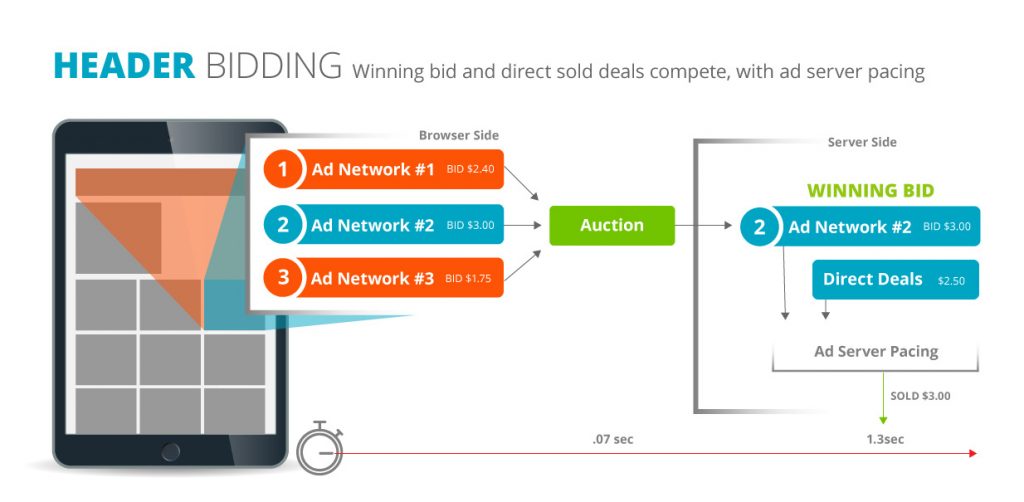Last updated on January 26th, 2023 at 04:10 pm
Everything remains pale and same unless a little change is added to make it all better, new and much more efficient because at the end of the day, is change not the only constant? With that being said, the advent of technology and its’ creeping into every sector has brought out major changes and put us at ease, and definitely reduced manual efforts. The advertising sector to has been affected by the same, and a lot of new platforms have come up, owing to the same. One such is Exchange Bidding, and another of the same kind is Header Bidding. Until the development of header bidding, Google dominated the adtech arena and took major advantage of the premium position that it had. They selected the very best inventory for themselves because the same was concealed from every other platform. The advent of Header Bidding has put an end to the umpteenth amount of advantage that Google initially received, and made every bid in the auction, available to everyone. This allows publishers to maximize revenue by allowing multiple exchanges to compete equally in a unified auction, where each publisher bids, with the same being visible to everyone, and the highest bid wins.
Publishergrowth: The Revenue Acceleration Platform for Publishers
Blognife is elated to announce the launch of Publisher Growth- a community of publishers that helps you actively accelerate your revenue. This platform assists publishers in growing their traffic and revenue. As publishers, you can share and read reviews of ad networks and hosting companies. You can connect with other publishers to build links for growth and monetization hacks and more. This platform will help you stay up to date with the advertising and publisher ecosystem.

Features:
Header Bidding is known to be a much cleaner and better tech integration between revenue partners, ad tech companies and publishers relatively. One might also have heard of the same as advance bidding or pre-bidding, irrespective, it is an advanced programmatic technique, where publishers offer inventory to several ad exchanges simultaneously before making calls to their ad servers. The basic idea behind the same is that by letting a couple of demand sources bid at the same time, publishers may get an opportunity to increase their revenue. Exchange bidding on the other hand is Google’s solution to Header Bidding where a selected number of partners are allowed to bid on Google’s partner sites’ inventory and the highest bid is served to the publishers. While, both of them seem quite impressive unless a complete study is done to evaluate both their pros and cons, one cannot select one.
Header Bidding vs Exchange Bidding: The Benefits for Publishers
The one major benefit of header bidding certainly is that it has done away with the partiality that gave Google excessive profits and laid out all the platforms and buyers on the same, equal level to compete with each other’s bids. When the same did not exist, Google remained the undefeated, unbreachable network, while the others had to guess what would bring them profits, putting the latter at utter delusion and disadvantage. Well, the ABCs of marketing dictates “Show me the money!” which is what the biggest benefit of header bidding is, that they have immense profits and merely adding a single header bid source can increase yield by 30 per cent. Other than that, if a publisher combines their inventory with a single SSP, they could sell inventory on a per-impression basis, which would provide them more transparency into the worth of per impression. Exchange bidding allows publishers to compete for their inventory with Google’s Exchange bidding partners which have a stronghold across America, Europe and another tier one countries. The technology stack from the publisher’s point of view is minimized since Google holds the auction and it is a directly integrated feature of DFP Premium.

Header Bidding vs Exchange Bidding: Ad Network Partners List
Exchange Bidding has 12 platforms that it has partnered with which include MobFox, RhythmOne and Sovrn are regionally restricted to the Americas and Europe only, with COMET working only in North America, and AerServ working in the Americas only. Other than that, they have Index Exchange, OpenX, Rubicon Project, Smaato and TripleLift. Header Bidding has a good number of partners, that they collaborate with and the same includes, including Criteo, Google(EBDA), Facebook, Amazon, AppNexus, Index Exchange, AOL Marketplace, Rubicon, OpenX and Centro. While Header bidding is developed using prebid which is open source, Exchange bidding is a custom solution developed by Google. The list of partners is comparatively higher in a header bidding setup, however, the biggest ones apart from Appnexus find a place in Google’s Exchange bidding as well.
Header Bidding vs Exchange Bidding: CPM Rates
The CPM in open Auctions, like exchange bidding, is decided by the price the buyer is willing to pay and the number of buyers there are. The more the demand is, the higher is the hike in price and the buyers and willing to pay much more than they would regularly. If it is the first look type, the buyers pay quite a premium price but the fill rates decrease. However, if it is the regular type, the prices are usually double. There have been reports that suggest a 30%- 60% increase in revenue, before the use of header bidding. Though for that, one has to put in the effort, work with the ideal number of header bidding partners, track them to keep the good ones and drop the bad ones, and in the process not neglect site latency. Pubmatic has seen gains as high as 50% on their publisher’s sites, owing to the latter. Exchange bidding also puts Google’s Ad Exchange buyers to bid higher on impressions and thus publishers who have enabled Exchange bidding can see a significant increase in overall ad revenue.
Header Bidding vs Exchange Bidding: Working Process
Header Bidding might seem a complicated process, but to put it out there for you, it basically is a simpler way, through which the publishers conduct direct auctions so that the inefficiencies are neglected and the best prices are sought for the ad space inventory. The web publisher puts some tech in the website’s header, and on the loading of a page on the site, the code reaches out to the supported ad exchange or the SSPs for bids before their own ad server’s direct sales are called. The bidding takes place simultaneously, rather than sequential, and focuses on all available impressions and not just the ones that are available after direct sales. Exchange Bidding, though is slightly more complicated, where, an ad request may be sent to DFP making use of Google Publisher Tags or the Google Mobile Ads SDK and with the same, information about the user or the user’s data is sent to DFP. Making use of the information that is provided, DFP labels all eligible line items signed in the DFP ad server and selects the best possible line item to compete via dynamic allocation in the unified auction. Before that, DFP sends a bid request to targeted yield partners, who process their own auction and return their most competitive bid to DFP, who then hosts a unified auction to then select a winner.
Header Bidding vs Exchange Bidding: Payment Terms
Header bidding has a lot of SSPs who have payment terms in NET 30, 45, 60, 75 days respectively. So, if you’re a big publisher who has individual tie-ups with these SSPs, you will be paid your share based on the net payment dates. However, if you’re working with an ad tech company and you’re providing your inventory via them, the usual payment terms include NET 60 to NET 80 days depending on the list of SSP partners. On the contrary, if you’re using Exchange bidding, you will be paid in NET 30 days which is Google’s standard payout date. Here is the link to signup with a good header bidding SSP partner.
What is Server-Side Header Bidding?
It is the execution of header bidding on the server instead of the browsers. This reduces the page latency and fees up to the limit implied on publishers. However, as publishers, you will face issues with the match rate in this technique.
Conclusion
While they may both seem like unicorns and fairies, they actually are not, and the truth is that everyone has skeletons in their cupboard. While exchange bidding has its set of drawbacks, so does header bidding. The usual problems for exchange bidding are that the yield group does not deliver any impressions, and the Ad Exchange and DFP reports do not always match. Nevertheless, both of these are really good to be used. That being said, header bidding increases the workload for publishers and they have to put in more effort, and other than that, it results in increased infrastructure costs.
Our Recommended Tools for Publishers:
- Best AdSense Alternative- Setupad, Ezoic
- Push Notification Network- iZooto, Unative,
- Best Contextual Ad Network- Media.net (Extra 10% for 3 months)
- Native Ad Network- Mgid
- Popup Ad Network- Exoclick, Propeller Ads
- Best Web Hosting- Bluehost, Hostgator, Stablehost, WPEngine
- Blogging Tools- OptinMonster, Astra, Teachable,

I and my team research various ad networks and can help you increase your overall ad revenue; so you could rake in more greenbacks with the best monetization platforms. Tap into the power of the online publishing business with me. I am just a mail away, so reach out to me if you want to scale up your website revenue. mail: [email protected]



3 thoughts on “Header Bidding vs Exchange Bidding: 2023”